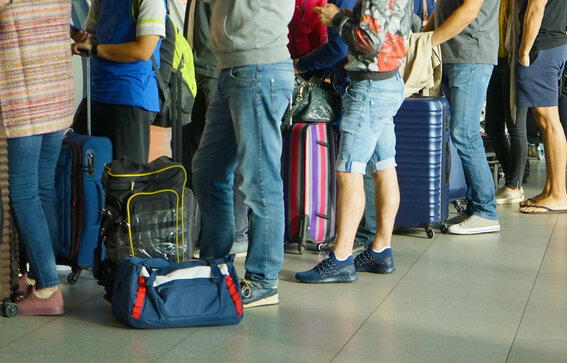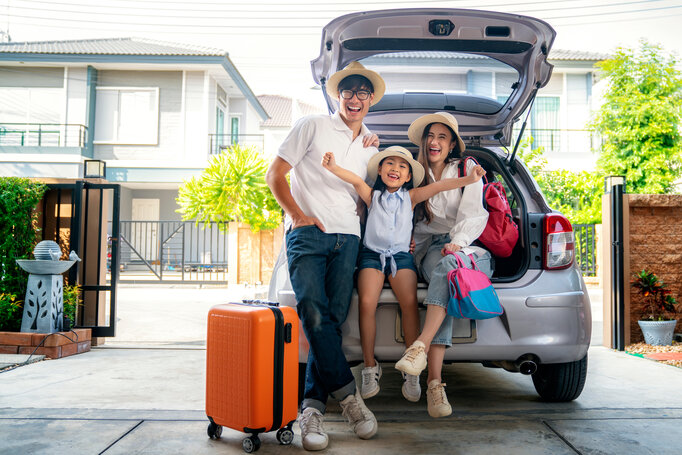
Although frustration with the service issues experienced in an uber-crowded summer season and a continued seriousness about financial concerns pose challenges for the travel & hospitality industry, the outlook for Fall travel still looks comforting.
IMPORTANT: These findings are brought to you from our independent research, which is not sponsored, conducted or influenced by any advertising or marketing agency. The key findings presented below represent data from over 4,000 American travelers collected in August 2022.
With the pumpkin spice latte making its 2022 debut and Labor Day celebrated, Americans said goodbye to summer. Keep reading for a summary of the key findings from the latest The State of the American Traveler report.
The Impact of the Congested, Short-staffed, Often-Chaotic Summer
Fully 62% of American travelers took at least one overnight trip between mid-May and mid-August. As was the case last month, 40% of these summer travelers reported experiencing at least one service issue on their trips, with problems caused by staffing shortages topping the list. In fact, 38% continued to agree it seemed like businesses in the travel industry were having trouble providing adequate service to their customers (although this metric is declining from a high of 42% in June). Nearly half (48%) of those who had a service issue on their trip rated their experience as more than moderately frustrating—with Gen X travelers exhibiting the highest levels of frustration, while Boomer-age travelers appeared more patient with the situation.
If you are wondering if these service issues have had an adverse impact on sentiment towards future travel, it certainly has taken hold in some travelers’ minds. In our latest survey, 31% of those who reported moderate to extreme levels of frustration with the service issues they experienced on their recent trips said that they are reconsidering their Fall travel plans specifically due to these frustrations. In addition, crowds/too many people traveling (17%) and the possibility of flight cancellations were among the top 10 travel deterrents Americans cited for why they didn’t travel more in the past few months.

The Outlook for Fall and Beyond
Despite the challenges facing travel, nearly two-thirds (64.7%) of American travelers still expect to take at least one overnight leisure trip in the next three months, and nearly half (47%) plan to take an overnight trip specifically to visit friends or relatives in this time frame. Currently, 29% of American travelers say they have a leisure trip planned in September and 30% have a leisure trip planned in October—on the rise since last month. Looking further ahead, a growing number of Americans say they are open to travel inspiration (68%; up nearly 7-points compared to July) and are increasingly excited about their travel in the future (80% report high levels of excitement for travel, up 4-points in the last month).
In terms of disruptions due to Covid, even with the latest variants, the virus’ impact on Americans’ ability to have meaningful travel experiences is in retreat. Now only 30% of travelers say Covid is still negatively impacting their travel experiences (down 17-points from the start of the year).
However, with so many believing the economy is—or will be soon—in a recession, the top travel deterrents remain firmly financial: the cost of gas, airfare, and travel in general being too expensive, as well as their own personal financial situation. Although falling gas prices have released some of the cost pressures travelers are facing—and, in turn, the proportion who say that they will be taking fewer road trips or road trips closer to home has declined from highs seen in June—inflation continues to be a significant issue. Over 30% of American travelers say recent inflation in consumer prices has led them to cancel an upcoming trip, and 45% say high prices have kept them from traveling in the past month. Over the past year, those who feel their personal financial situation is stronger than it was relative to the year prior has fallen from 41% in August 2021 to 27% in August 2022.
Nevertheless, many Americans remain optimistic about their pocketbooks and future travels. This month saw a more than 5-point increase in the proportion of travelers who feel that a year from now, they will be better off financially than they are now (45%). Expectations for travel over the next year are also up. When asked if they expect to take more or fewer trips in the next 12 months (compared to the previous 12 months) 31% of travelers said they’d be taking more trips, up from 28% in July.

Travel Attitudes & What’s Hot Right Now
Here are some highlights of what American travelers are finding particularly appealing about travel right now:
- The most desired domestic destinations that leisure travelers want to visit in the next 12 months are Florida, New York, Las Vegas, California and Hawaii.
- The topmost desired international destinations that leisure travelers want to visit in the next 12 months are Italy, Mexico, Canada, France and Spain.
- American leisure travelers are most excited to take family trips and romantic getaways in the next 12 months. Their top travel priorities are spending time with loved ones, visiting new places they haven’t been before, having fun, relaxing and being happy.
- Luxury travel is also on trend for leisure travelers, with 37% of American travelers reporting that luxury travel experiences are typically important components of their leisure trips. They also prefer visiting new places (53%) and having “active time” vacations (45%).
- Travel transportation preferences remained the same compared to last month, with almost half of travelers reporting they prefer road trips (46%). One-quarter prefer trips on a commercial airline (26%) and 12% say they prefer taking a cruise line.
- This month, 27% of leisure travelers agreed that they are more interested in traveling outside of the United States than inside the United States. This remains consistent with the levels we saw in July.
- While interest in international travel has held steady with last month’s findings, American leisure travelers are now expressing a higher likelihood to travel outside of the United States for leisure travel in the next 12 months compared to July. 31% of respondents reported that they are likely or very likely to travel internationally in the next year, up from 26% last month.
Marketing Travel
To help the industry understand how to target American travelers with travel-related messaging, regardless of where they are in the travel planning process, we track which streaming services, news sources, and magazines (printed or online) they have used regularly in the past 12 months. Here are some highlights from this month:
- When it comes to general media consumption habits, the streaming services American travelers primarily consume include Netflix (68%), Amazon Prime Video (56%), Hulu (47%) and Disney+ (40%). Looking at generational differences, Millennials or younger tend to outpace older generations in their usage of Netflix, Hulu and Disney+. Gen Xers are more inclined to subscribe or watch Amazon Prime Video, Peacock and Paramount+, while nearly a quarter (24.3%) of Baby Boomers or older do not subscribe to the streaming services we asked about.
- The top news sources used on a regular basis include CNN (23%), ABC News (23%), Fox News Channel (22%), NVC News (22%) and CBS News (21%). In contrast to their consumption of streaming services, Baby Boomers or older are more likely to consume news content compared to younger generations. In particular, Boomers have a higher propensity to use ABC News, Fox News Channel, NBC News and CBS News.
- As for magazines, whether printed or online, AARP (16%), People (12%) and Travel + Leisure (11%) are the most consumed publications among American travelers. Far and away, Baby Boomers or older are more inclined to consume AARP content (magazine or bulletin).
- Looking more deeply into American attitudes toward travel messaging, one-third (34%) say they do not see themselves represented in travel advertisements. There is an opportunity to diversify travel messaging to ensure all travelers feel welcomed to the destination.
- In terms of planning windows for marketers to bear in mind, American travelers are planning their domestic leisure trips about 11.4 weeks in advance on average for trips with a length of stay of one week or longer.
- As for where marketers can best reach travelers, Americans are most receptive to learning about new destinations through websites found via search engine (32%), followed by Facebook (23%), review websites (23%) and online content (22%). TikTok was by far the most popular channel for Gen Z travelers to learn about new destinations (44%), while Millennials were most likely to select Facebook (31%). Websites found via search engine were the top choice for Gen X (35%) and Baby Boomers (36%).
Don’t forget to register for our upcoming webinar.









